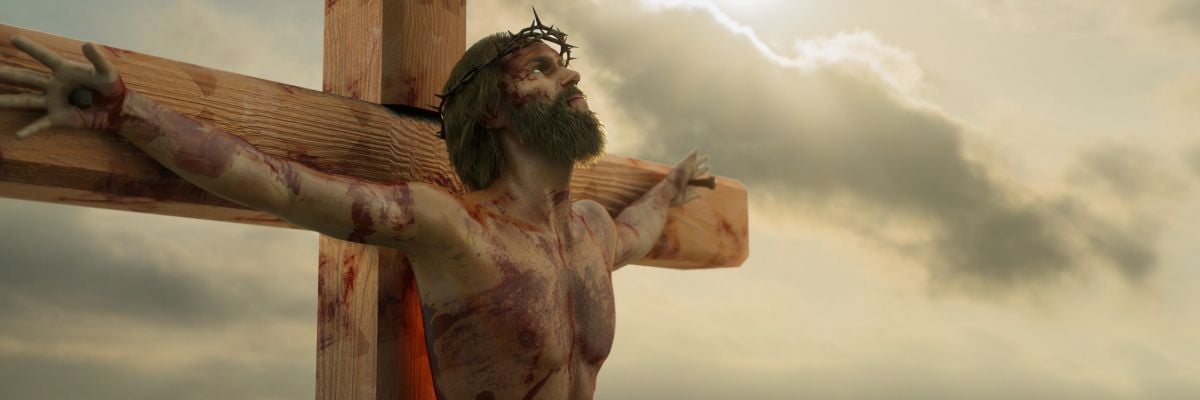
The narratives of Jesus’ passion and death are among the most sacred elements of Scripture for Christians. For skeptics, however, they’re often used as a punching bag. The claim is that they’re historically unreliable because the Gospels supposedly contradict themselves.
Previously, we looked at two alleged contradictions involving the timing of Jesus’ trial. Yet, critics often raise challenges based on what they believe are contradictions concern the timing of Jesus’ death.
For example, Mark tells us that Jesus ate the Last Supper “on the first day of Unleavened Bread, when they sacrificed the Passover lamb” (Mark 14:12), and he died the next day (Mark 14:12, 17). But John places Jesus’ death on “the day of preparation of the Passover” (John 19:14).
Another objection is that Mark and John also contradict each other as to the hour Jesus was crucified. Mark claims it was at “the third hour” (Mark 15:25), which according to the Jewish division of twelve-hour days and nights would have been 9 am. John tells us Pilate questioned Jesus “about the sixth hour” (John 19:14), which means Jesus wouldn’t have been crucified until some time after, probably right at twelve noon according to the same Jewish division of days.
Agnostic New Testament scholar Bart Ehrman finds in the discrepancy a reason for doubt: “It is impossible that both Mark’s and John’s accounts are historically accurate, since they contradict each other on the question of when Jesus died.”
What should we make of these apparent contradictions? Are they proof that Mark and John can’t be historically reliable, as Ehrman says? Let’s first take the question as to whether Jesus was crucified before or after Passover.
Some have responded to the objection by saying the Sadducees and Pharisees celebrated Passover on different days, and Jesus sided with the Pharisees.
Others, like Pope Emeritus Benedict XVI, have proposed Jesus may have celebrated Passover in accord with the Qumran calendar, which would have been one day earlier than the celebration of Passover involving the priestly sacrifices of lambs.
Both responses to the objection have merit. But there’s another way that uses the text of the Gospels themselves.
The phrase “day of Preparation” is a Jewish idiom for Friday, the day that Jews made preparations for observance of the weekly Sabbath.
All three Synoptics use the idiom this way and say Jesus died on that day. Mark is explicit: “And when evening had come, since it [the day Jesus was crucified and died] was the day of Preparation [Greek, paraskeuē], that is, the day before the Sabbath” (Mark 15:42; emphasis added).
Luke is explicit as well. In reference to the day of Jesus’s crucifixion and death, he writes, “It was the day [hēmera] of preparation [paraskeuēs], and the sabbath was beginning” (Luke 23:54).
Matthew’s use of paraskeuē is a bit more implicit. He identifies the day Jesus died to be “the day of preparation” (Matt. 27:62). He then speaks of Pilate appointing guards to guard Jesus’ tomb on the day “after the day of preparation,” which he clearly identifies as the Sabbath in 28:1.
Even the Gospel of John itself, like the Synoptics, uses paraskeuē to refer to Friday in the other two passages where it’s used.
In John 19:31, the evangelist refers to the day of Jesus’ crucifixion as paraskeuē. But within the same verse it becomes clear that he’s not talking about the day on which Jews prepare for Passover, but the day before the Sabbath, Friday:
Since it was the day of Preparation [paraskeuē], in order to prevent the bodies from remaining on the cross on the sabbath (for that sabbath was a high day), the Jews asked Pilate that their legs might be broken, and that they might be taken away” (emphasis added).
Notice the problem the Jews seek to solve is having the bodies on the crosses on the Sabbath. This implies that the day on which the request to remove the bodies is made is the day before the Sabbath, Friday. And it’s that day that John calls paraskeuē, “the day of Preparation.”
This interpretation is strengthened a few verses later when John tells us why they sought a nearby tomb: “So because of the Jewish day of Preparation [paraskeuē], as the tomb was close at hand, they laid Jesus there” (John 19:42). They needed to quickly bury Jesus lest they violate the Sabbath rest, which was soon to begin that Friday after sundown.
Given the evidence from both the Synoptics and John himself that the phrase “day of Preparation” is an idiom for Friday, the day of preparation for the weekly Sabbath, it’s reasonable to conclude that’s how John is using it in John 19:14.
But why add the phrase, “of the Passover”?
The term “Passover” doesn’t only refer to the initial Seder meal, during which the Passover lamb is eaten. As New Testament scholar Brant Pitre points out, by the first-century A.D., “Passover” came to be used interchangeably with the seven-day “feast of Unleavened Bread.” Luke provides us with an example: “Now the feast of Unleavened Bread drew near, which is called the Passover (Luke 22:1; cf. Lev. 23:6-8; emphasis added).
So, it seems that by adding the extra tidbit “of the Passover” John intends to highlight the special character of that Friday, the day of preparation for the Sabbath during Passover week.
This provides a possible explanation as to why John says, “that Sabbath was a high day” (John 19:31). It wasn’t just an ordinary Sabbath. It was a Sabbath that fell during Passover week. Consequently, it was a “doubly sacred” Sabbath.
Since John is not referring to the preparation day for Passover, and places Jesus’ crucifixion on the same day that Mark does, Friday, it follows that there is no discrepancy between the two, at least when it comes to the day on which Jesus was crucified.
In fact, all of the Gospels state that Jesus was crucified and buried on “the day of Preparation” (Matt. 27:62; Mark 16:42; Luke 23:54; John 19:14, 31, 42)—so all four agree.
What about the hour of Jesus’s crucifixion? Was it 9 am, as Mark says? Or, was John right when he said it took place at noon?
New Testament scholar Craig Blomberg explains that just as the Jews divided the twelve-hour night (sunset to sunrise) into four watches, so too they divided daylight hours (sunrise to sunset) into four three-hour increments. And they generally identified the time of events during the day by rounding up or down to the quarter hour.
For example, throughout the Synoptics, almost every time the authors speak of an hour of the day they speak of the “third,” “sixth,” and “ninth” (Matt. 20:3, 5; 27:45, 46; Mark 15:33, 34; Luke 23:44; Acts 2:15; 3:1; 10:3,9, 30; 23:23). The only exception is the parable of the tenant that receives his reward in the “eleventh” hour (Matt. 20:9). But such specificity is required by the parable.
In light of this, Blomberg concludes, “it becomes plausible to interpret Mark’s ‘third hour’ to mean any time between 9 a.m. and noon” (emphasis added). Mark just rounds down to the “third hour” whereas John rounds up to the sixth. John’s rounding up is supported by the fact that he says it was “about the sixth hour” (John 19:14).
Given that Mark and John are approximating the time of Jesus’ death, and they both approximate that time to be some time in the second quarter of the day, we can conclude there is no contradiction.
Ehrman may still reject the historical accuracy of Mark and John. But he can’t do so on the grounds that Mark and John contradict each other as to the day and hour of Jesus’ death.



